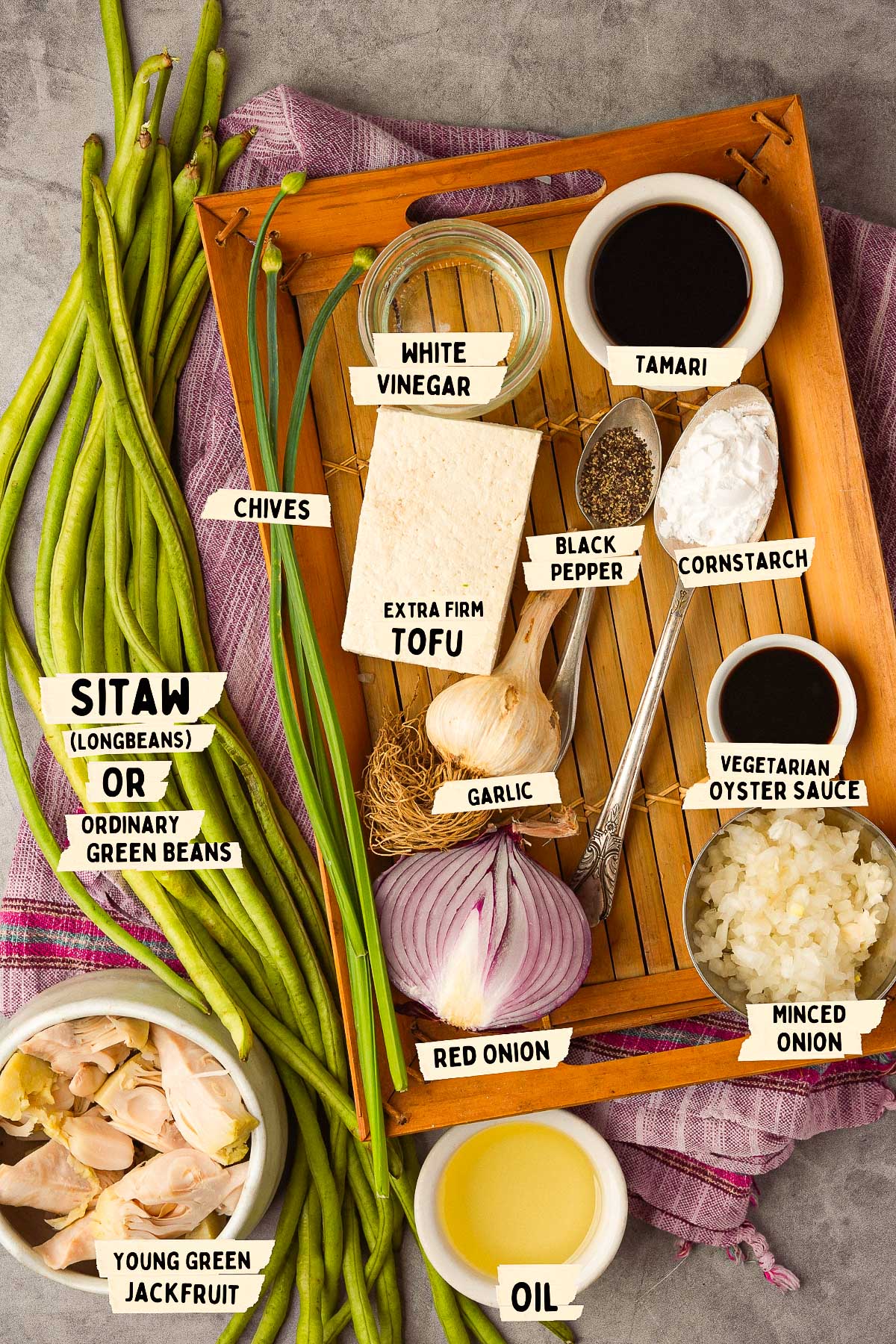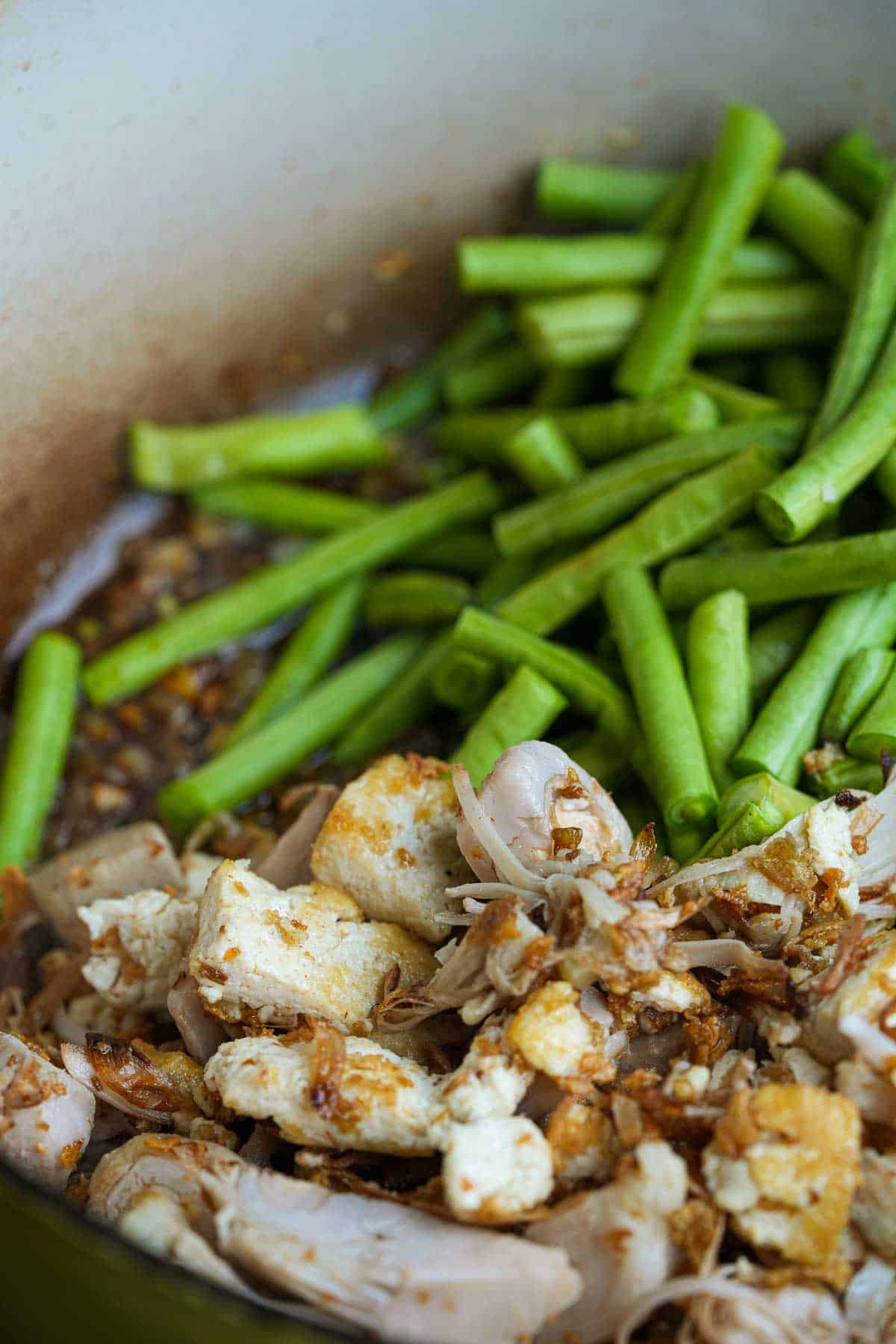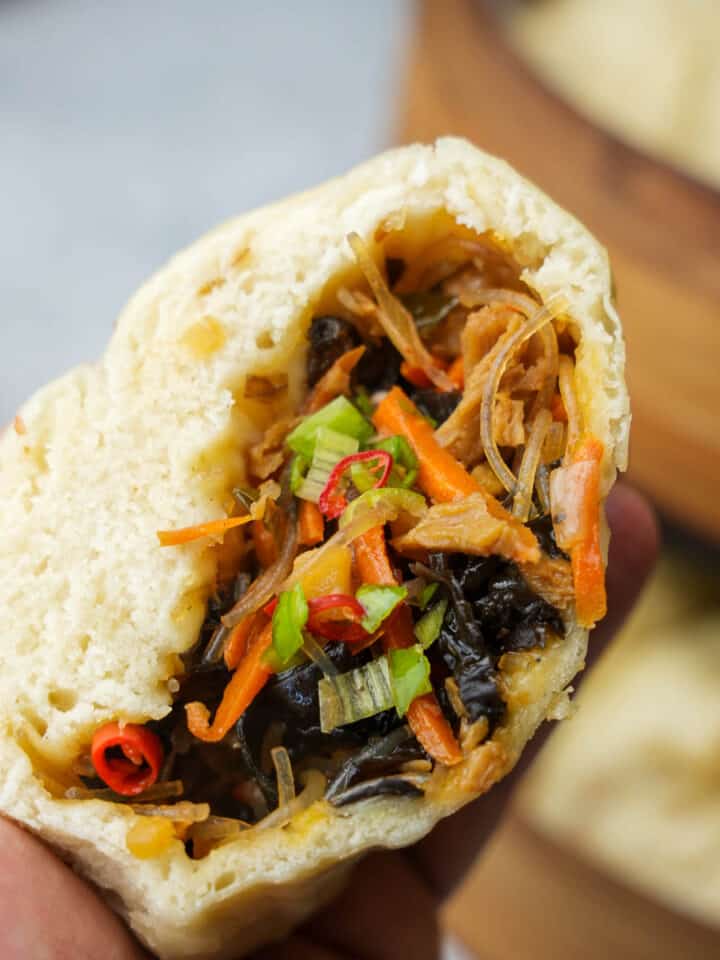*This post may contain affiliate links. Read more »
Are you in the market for an insanely good adobong sitaw recipe without meat in it? Well, m'love, you seriously hit the jackpot here. This classic Filipino adobong sitaw with tofu (long bean adobo) is a plant-based spin on pork adobo, crafted by an award winning chef, and then tested and loved by hundreds of people all around the world. And with langka (jackfruit) and fried tofu in it, this bad boy's really got something to sink your teeth into if you are trying to live your best pork-free adobong sitaw life...


Enter your email & I'll send it to your inbox. Plus, get great new recipes from me every week!
By submitting this form, you consent to receive emails from Cinnamon Snail.
When I was in the Philippines representing the USA at the World Street Food Congress, cooking for thousands of people each day, I was blown away by how prevalent pork is in local cooking and how absolutely crazy people get about it. So in veganizing some of the most popular dishes in Filipino cuisine, I wanted to replace the pork with something that had similar textures without harming any pigs. I’m here to guide you through how to cook this dish right the first time and make your first attempt an absolute triumph.
This is a side dish, which is a particular style of adobong sitaw (sauteed string beans) that rocks a little protein and some nice meaty textures, although it’s completely vegan and gluten-free! It makes a fantastic accompaniment to Filipino classics like smokey ensaladang talong, crispy tofu sisig, and banana leaf grilled tupig.
Whether you're a seasoned chef or sorta timid in the kitchen, this perfect sitaw recipe will become a cherished addition to your repertoire. So get your apron on, gather your ingredients, because you and the pig you aren’t gonna eat are BOTH in for a treat!
Jump to:
- 🤷♀️ What is adobong sitaw?
- 🥰Why you'll love this adobong sitaw recipe without meat
- 🧅 Important ingredients for adobong sitaw
- 🤯Variations
- 📖 How to cook adobong sitaw with tofu without pork
- 💡Serving Ideas
- 👉Top tips to NAIL this adobong sitaw recipe
- 🤷♀️FAQ
- ✌️My faves to serve with this adobong sitaw recipe:
- Adobong Sitaw (Filipino long beans with Tofu and Jackfruit “Pork”)
🤷♀️ What is adobong sitaw?
Sitaw is the Filipino word for long beans, but you can make this great dish with green beans, runner beans or French string beans. "Adobo" is a cooking method that's been passed down through generations in the Philippines, marinating or cooking ingredients in a balanced blend of soy sauce, vinegar, and aromatics.


🤫 Learn the secrets for perfect vegan Filipino meals
This guide to my most popular plant-based recipes from the Philippines is 100% FREE, & you'll love the actual heck out of it 🥰
🥰Why you'll love this adobong sitaw recipe without meat
✊Vegan AF and GF: Like all the vegan recipes I share, this ginisang sitaw ditches animal products without compromising on flavor or texture. It also just happens to be totally free of wheat. You hate gluten so much that you want to put all the wheat on planet Earth into a rocket and launch it into the sun? I got you. Don’t you worry about that.
🌟 Stellar Ingredients: Can’t find proper sitaw? Don’t sweat it - I share tons of substitutions for any hard-to-find ingredients that have been tested and work perfectly.
✅ Tested and Approved Worldwide: Like all of my vegan Filipino recipes, this Adobong Sitaw recipe has undergone many revisions to be perfect, and then has been shared with a massive crew of recipe testers. You can trust it to shine, no matter where you are or what brands of ingredients you have.
🧅 Important ingredients for adobong sitaw

Young Green Jackfruit (Langka)
Young green jackfruit adds a delightful meaty texture to your Adobong Sitaw, often referred to as "pork" due to its resemblance. It soaks up the savory sauce, making it a hearty substitute, and that’s the reason why I also make my vegan tamales, the Indian curry Kathal ki Sabji, and vegan drumsticks with it!
If you can't find jackfruit, you can use pulled oyster mushrooms, seitan, soy curls, or hand torn pieces of this awesome vegan ham recipe.
Sitaw
Adobong Sitaw is traditionally made with long beans (also sometimes called snake beans). I use them in dishes like sambal goreng, and sayur lodeh. Don’t freak out if you can’t find them at your local Asian grocery store. Green beans (the regular ol’ ones like you would use for making urap sayur), or runner beans (like you would use for making Zeytinyağlı Taze Fasulye) or even French-style haricots verts will work just fine in place of them.
Tamari
Tamari is a gluten-free soy sauce. If gluten is an issue for you, but you don’t have tamari, you can use coconut aminos or liquid aminos. Otherwise, any ol’ soy sauce you like will work fine in its place, but of course it won’t be gluten-free.
Vegetarian Oyster Sauce
This sauce isn’t just for adding rich umami flavor to your favey noodle dishes like bihun goreng, and pad woon sen. It is typically made from mushrooms. If you're unable to find vegetarian oyster sauce, hoisin sauce or mushroom soy sauce can replicate the depth it provides.
*See the recipe card at the bottom of the page for exact quantities, nutritional info, and detailed cooking directions.
🤯Variations
Ginataang Adobong Sitaw Recipe
This way of making sitaw comes from the Bicol region of the Philippines, known for its love of coconut-based dishes. Ginataang mean cooked in coconut milk. Anyway, to make this version, add a small amount of full-fat canned coconut milk, and a pinch of coconut sugar to my Adobong Sitaw recipe. The result is a creamy, slightly sweet, and aromatic dish that balances the savory flavors.
Adobong Sitaw with Peanut Sauce
In the northern Philippines, particularly in the Ilocos region, a unique twist on Adobong Sitaw is made by incorporating a peanut-based sauce. I love it this way. You can simply grab the peanut sauce recipe from my ketoprak and spoon some of that on top of the finished dish.
📖 How to cook adobong sitaw with tofu without pork
This adobong sitaw with tofu is simple, satisfying, and designed to deliver bold flavor without the meat. Nail these long beans on your first shot by following these step-by-step instructions with important tips. Or you can follow along with the easy-to-print recipe card towards the bottom of this page.

Step One
Sear Tofu and Jackfruit:
In a pan, warm canola oil, peanut oil, or vegetable oil over high heat. After 90 seconds, when the oil reaches the desired temperature, stir-fry the tofu and jackfruit for approximately 7 minutes until they attain a golden-brown, slightly crispy exterior. Using a slotted spoon, remove the contents from the pan and set them aside.

Step Two
Sauté Aromatics:
Lower the heat under the same pan to medium, add a little extra oil, finely minced onion and minced garlic. Sauté these aromatic elements for a couple of minutes until they exude a fragrant, translucent quality.

Step Three
Prepare Sauce:
Blend tamari (or soy sauce), white vinegar, black pepper, and vegetarian oyster sauce in a separate bowl.

Step Four
Mad Juice:
Add this flavorful sauce mixture to the sautéed aromatics and stir.

Step Five
Combine Ingredients:
Reintroduce the seared tofu and jackfruit to the pan, along with the sitaw (or green beans) cut into 2 inch/5cm sections. Stir-fry for a few minutes, ensuring the sitaw reaches a delightful, slightly tender state, without overcooking.

Step Six
Thiccccc:
Create a thin milky slurry by mixing cornstarch and water. Carefully pour this cornstarch mixture into the pan, allowing the sauce to simmer and thicken.

Step Seven
Ladies, preeeesent:
Have you ever seen Adobong Sitaw without pork look so gosh-darned gorgeous?!?Transfer the cooked sitaw to an attractive serving dish, and garnish with finely minced red onion and either scallions or garlic chives. Serve with some achara on the side!
💡Serving Ideas
Adobong Sitaw pairs beautifully with an array of Southeast Asian dishes to make a well-rounded meal.
Serve sitaw with other Filipino veggie dishes like laing, vegan lumpiang Shanghai, Ginisang Munggo, or Ginataang Kalabasa. The classic Filipino street food suman or taho are nice light desserts to serve afterward!
To make it into a bowl-style meal, you can enjoy it with Tom Yum Fried Rice, Nasi Minyak, Indonesian Coconut Rice, Turmeric Rice or Khao Pad. For something more to sink your teeth into, serve it with crispy Tofu Katsu or Vegan Fried Chicken, drizzled with Nuoc Mam or spicy Nam Prik Pao.
Upgrade the flavors of the sitaw by adding some tangy Pickled Burdock, Spicy Cucumbers, chili garlic sauce, or Pickled Green Chilies.
And for those who are total veggie freaks like me, serve this alongside Asinan Sayur, Miso-Glazed Eggplant, or Urap Sayur Salad.

👉Top tips to NAIL this adobong sitaw recipe
- Dry your Tofu and Jackfruit: If you want to get a nice golden sear and a meatier texture, its ESSENTIAL the tofu and jackfruit are well-drained and pressed dry to remove excess moisture. A tofu press is great if you have one, otherwise a little gentle pressure over some clean kitchen towels will do the trick to remove the extra tofu blood! Just kidding. Tofu has no blood. Dracula already ate that part.
- Balancing Act of Flavors: Pay attention to the balance of savory and tangy flavors in the sauce. Adjust the tamari (or soy sauce), white vinegar, and vegetarian oyster sauce to your personal taste. If you like less salt in your food, start with very little soy sauce, and add to it gradually to get it how you like it.
- Timely Addition of Sitaw: Add the sitaw (or green beans) towards the end, as I have recommended it. You can always cook it longer, but I really think it’s best when the sitaw is just slightly tender but not overcooked.
🤷♀️FAQ
Not really. It is often made with pork, and sometimes shrimp paste too. If you see it on a non-veg restaurant menu, don’t assume it is plant-based.
If jackfruit is unavailable, you can use pulled oyster mushrooms, seitan, soy curls, or textured vegetable protein (TVP) as a replacement.
Absolutely. It is not spicy on its own, but you can add chili flakes, shatta, or hot sauce of your preference to increase the spiciness.
Storing Adobo style green beans is a breeze, and reheating is a cinch. To maintain its texture and flavor don’t freeze this dish. Here's how to reheat:
🔥 Stovetop Reheating:
Place your Adobong Sitaw in a pan or skillet.
Add a splash of water (about 2-3 tablespoons) to prevent sticking and maintain moisture.
Heat the dish on medium-low heat, stirring occasionally.
Once it's thoroughly heated (usually within 5-7 minutes), it's ready to serve.
🍲 Microwave Reheating:
Transfer your Adobong Sitaw into a microwave-safe container.
If the dish has thickened in the refrigerator, you can add a touch of water to maintain the sauce's consistency.
Cover the container with a microwave-safe lid or microwave-safe plate.
Heat on medium power for 2-3 minutes, pausing to stir midway.
Ensure it's evenly heated, and you're good to go.
✌️My faves to serve with this adobong sitaw recipe:

Adobong Sitaw (Filipino long beans with Tofu and Jackfruit “Pork”)
Equipment
- Measuring Cups and Spoons
Ingredients
- ⅓ cup canola oil peanut oil, or vegetable oil
- 7 oz. Extra firm tofu half a block, pressed dry
- 20 oz. young green jackfruit drained and squeezed dry
- 1 teaspoon olive oil
- ⅓ cup onion finely minced
- 5 cloves garlic minced
- 3 tablespoons tamari or soy sauce
- ¼ cup white vinegar
- ½ teaspoon ground black pepper
- 1 tablespoon vegetarian oyster sauce
- 1 lb. sitaw (or green beans), cut in 2 inch / 5 cm. sections
- 2 teaspoons cornstarch
- ¾ cup water
To Garnish:
- Finely minced red onion
- Scallions or garlic chives
Instructions
- In a pan, heat canola oil, peanut oil, or vegetable oil over high heat. After 90 seconds, when the oil is hot, stir-fry the tofu and jackfruit for about 7 minutes until it turns golden brown. Remove the contents of the pan with a slotted spoon and set it aside.
- In the same pan over medium heat, add another teaspoon of oil, minced onion and garlic. Sauté for a couple of minutes until they become fragrant and translucent.
- Combine tamari (or soy sauce), white vinegar, black pepper, and vegetarian oyster sauce. Add this sauce mixture to the sautéed aromatics and stir well to combine.
- Return the fried tofu and jackfruit to the pan along with the sitaw (or green beans), cut in 2 inch/5cm sections. Stir-fry for a few minutes until the sitaw are just slightly tender, but not overcooked.
- Mix together cornstarch and water to form a thin, milky slurry. Pour the cornstarch mixture into the pan and allow the mixture to simmer until the sauce thickens.
- Transfer to an attractive serving dish and garnish with finely minced red onion and scallions or garlic chives.
Notes

Enter your email & I'll send it to your inbox. Plus, get great new recipes from me every week!
By submitting this form, you consent to receive emails from Cinnamon Snail.











Leave a Reply